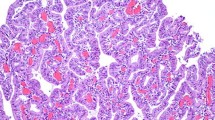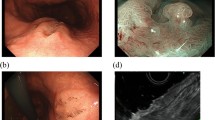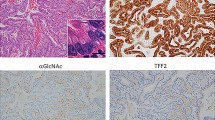Abstract
A pyloric gland adenoma (PGA) of the stomach was first described in a book chapter in 1976 by Kurt Elster and has been rarely reported in the literature. We expanded the current immunohistochemical data of these adenomas in a detailed series to further analyse the immunhistochemical status of PGA. From 60 patients with PGA with and without adenocarcinomas of the gastrointestinal tract, an immunhistochemical panel of Mucin 2, Mucin 5AC, Mucin 6, CD10, Ki67 and p53 was used to define the expression of these markers. All PGA were positive for Mucin 6 (deep mucoid glands), which they express over the whole lesion up to the surface. Mucin 5AC expression varies from case to case. A transition from gastric to intestinal differentiation can be observed focally as depicted by Mucin 2 and CD10 in 65% of the cases. The gastric corpus mucosa of elderly patients with either Helicobacter pylori gastritis or autoimmune gastritis is highly affected. Almost 47% of all PGA already underwent malignant transformation into adenocarcinoma. Significant immunohistochemical differences could be detected between PGA with and without adenocarcinoma regarding ki67 and p53. The diagnosis of PGA can be confirmed immunohistochemically by staining against apomucin 6 and apomucin 5AC. Focal intestinal differentiation supports the hypothesis that gastric adenocarcinomas can initially develop from carcinomas of the gastric type and transform into intestinal type later on. The high frequency of malignant transformation of PGA underlines its high potential for invasive malignancy.









Similar content being viewed by others
References
Eidt S, Stolte M (1989) Gastric glandular cysts–investigations into their genesis and relationship to colorectal epithelial tumors. Z Gastroenterol 27:212–7
Oberhuber G, Stolte M (2000) Gastric polyps: an update of their pathology and biological significance. Virchows Arch 437:581–590
Kushima R, Müller W, Stolte M, Borchard F (1996) Differential p53 protein expression in gastric adenomas of gastric and intestinal types: possible sequence of p53 alteration in the stomach carcinogenesis according to histological and mucin histochemical phenotypes. Virchows Arch 428:223–227
Hamilton SR, Aaltonen LA (eds) (2000) WHO classification of tumours. Tumours of the digestive system. IARC, Lyon
Borchard F, Ghanei A, Koldovsky U, Hengels KJ, Bückmann FW (1990) Gastrale Differenzierung in Adenomen der Magenschleimhaut Immunhistochemische und elektronenmikroskopische Untersuchungen. Verh Dtsch Ges Pathol 74:528
Kato N, Akiyama S, Motoyama T (2002) Pyloric gland-type tubular adenoma superimposed on intraductal papillary mucinous tumor of the pancreas. Pyloric gland adenoma of the pancreas. Virchows Arch 440:205–8
Watanabe H, Gass JF, Sobin LH (1990) Histological typing of oesophageal and gastric tumours. Spinger, Berlin
Elster K (1976) Histologic classification of gastric polyps. In: Morson BC (ed) Pathology of the gastro-intestinal tract. Springer, Berlin, pp 78–92
Borchard F (1987) 16. Tutorial IAP, Tumoren des oberen Gastrointestinaltraktes, Düsseldorf
Kushima R, Rüthlein HJ, Stolte M, Hattori T, Borchard F (1999) Pyloric gland-type adenoma arising in heterotopic gastric mucosa of the duodenum with dysplastic progression of the gastric type. Virch Arch 435:452–7
Bakotic BW, Robinson MJ, Sturm PD, Hruban RH, Offerhaus GJ, Albores-Saavedra J (1999) Pyloric gland adenoma of the main pancreatic duct. Am J Surg Pathol 23:227–231
Itoi T, Watanabe H, Ajioka Y, Ooohashi Y, Takei K, Nishikura K, Nakamura Y, Horic A, Saito T (1996) APC, K-ras codon 12 mutations and p53 gene expression in carcinoma and adenoma of the gall-bladder suggest two genetic pathways in gall-bladder carcinogenesis. Pathol Int 46:333–340
Kushima R, Remmele W, Stolte M, Borchard F (1996) Pyloric gland type adenoma of the gallbladder with squamoid spindle cell metaplasia. Pathol Res Pract 192:963–969
Takei K, Watanabe H, Itoi T, Saito T (1996) p53 and Ki-67 immunoreactivity and nuclear morphometry of "carcinoma-in-adenoma" and adenoma of the gall bladder. Pathol Int 46:908–917
Michal M, Crurik R, Matler K, Benes Z (2003) Regarding the paper by Vieth et al. Virchows Archiv 443/4:317-321. Virchows Archiv 443:589–590
Ishii K, Hidaka E, Katsuyama T, Ota H, Shiozawa T, Tsuchiya S (1999) Ultrastructural features of adenoma malignum of the uterine cervix: demonstration of gastric phenotypes. Ultrastruct Pathol 23:375–81
Mikami Y, Hata S, Fujiwara K, Imajo Y, Kohno I, Manabe T (1999) Florid endocervical glandular hyperplasia with intestinal and pyloric gland metaplasia: worrisome benign mimic of "adenoma malignum". Gynecol Oncol 74:504–11
Vieth M, Kushima R, Borchard F, Stolte M (2003) Pyloric gland adenoma: a clinico-pathological analysis of 90 cases. Virchows Arch 442:317–321
Kushima R, Mukaisho K, Vieth M, Borchard F, Stolte M, Hattori T (2003) Pyloric-gland-type adenomas of the stomach. Stomach and Intestine (Tokyo) 38:1377–1387
Kushima R (2004) Pyloric gland adenoma. Pathology and Clinical Medicine 22:634–635
Kushima R, Vieth M, Borchard F et al (2006) Gastric-type well-differentiated adenocarcinoma and pyloric gland adenoma of the stomach. Gastric Cancer 9:177–184
Chen ZM, Scudiere JR, Abraham SC, Montgomery E (2009) Pyloric gland adenoma: an entity distinct from gastric foveolar type adenoma. Am J Surg Pathol 33:186–93
Remmele W, Stegner HE (1987) Vorschlag zur einheitlichen Definition eines Immunreaktiven Score (IRS) für den immunhistochemischen Östrogenrezeptor-Nachweis (ER-ICA) im Mammakarzinomgewebe. Pathologe 8:138–140
Shiroshita H, Watanabe H, Ajioka Y, Watanabe G, Nishikura K, Kitano S (2004) Re-evaluation of mucin phenotypes of gastric minute well-differentiated-type adenocarcinomas using a series of HGM, MUC 5AC, M-GGMC, MUC 2 and CD10 stains. Pathol Int 54:311–321
Kushima R, Jancic S, Hattori T (1993) Association between expression of sialosyl-Tn antigen and intestinalization of gastric carcinomas. Int J Cancer 55:904–8
Hattori T, Kushima R (2001) Gastric differentiated stomach adenocarcinoma. Pathologe 22:97–104
Bamba M, Sugihara H, Kushima R, Okada K, Tsukashita S, Hattori T (2001) Time dependent expression of intestinal phenotype in signet ring cell carcinomas of the human stomach. Virchows Arch 438:49–56
Kushima R, Vieth M (2010) Tubular adenoma of the stomach with special reference to the Japanese criteria and pyloric gland adenoma. Pathologe 31:177–81
Acknowledgement
This manuscript is dedicated to Professor Manfred Stolte on occasion of his 70th birthday. The authors declare no conflict of interest.
Author information
Authors and Affiliations
Corresponding author
Additional information
M. Vieth and R. Kushima share first authorship. MV is supported by a grant of the Japanese Society of Pathology for a scholarship at the Shiga University of Medical Science, Department of Pathology, Ohtsu, Japan.
Rights and permissions
About this article
Cite this article
Vieth, M., Kushima, R., Mukaisho, Ki. et al. Immunohistochemical analysis of pyloric gland adenomas using a series of Mucin 2, Mucin 5AC, Mucin 6, CD10, Ki67 and p53. Virchows Arch 457, 529–536 (2010). https://doi.org/10.1007/s00428-010-0968-7
Received:
Revised:
Accepted:
Published:
Issue Date:
DOI: https://doi.org/10.1007/s00428-010-0968-7




